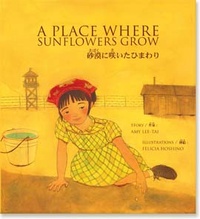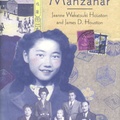As the granddaughter of prominent Japanese American painter Hisako Hibi, Amy Lee-Tai was exposed to art at an early age—and it was through her grandmother’s paintings that Amy first learned of the Japanese American incarceration during World War II. Amy’s first book, A Place Where Sunflowers Grow, was inspired by her family’s internment experiences and the art schools that gave internees moments of solace and expression.
Like the character Mari in the book, Amy’s mother’s family had an artist mother and father, an older son, and a younger daughter who were sent to the Tanforan assembly center and then to the camp at Topaz. Like Mari and her mother, Amy’s grandmother and mother planted sunflowers seeds outside their barrack, and her grandfather and mother walked to and from the Topaz art school together just as Mari and her father do in the story. While growing up, Amy’s mother, Ibuki Hibi Lee, and uncle, Satoshi Hibi, were exposed to art and were encouraged to draw and paint. Like Mari in the story, they took art classes at Topaz.
A Place Where Sunflowers Grow, illustrated by Felicia Hoshino, is a beautiful tribute to the life, legacy and artwork of Amy’s grandmother, artist Hisako Hibi. “My grandmother was a pioneering Issei woman,” says Amy.
Hisako came to America with her family when she was 13 years old, but when she was 18, her parents decided to take the family back to Japan. Hisako, the oldest of six children, refused to return with them. She had decided to remain in America and become an artist. She made America her home, attending high school and then the California School of Fine Arts in San Francisco, where she met Amy’s grandfather, Matsusaburo Hibi in the 1920s. As professional artists, Hisako and Matsusaburo painted before, during, and after the Japanese American incarceration. Amy says, “While they took on other jobs to support their family, painting was their calling and passion. Their creative process was their life.”
Less than two years after the internment, Amy’s grandfather died, leaving Hisako alone and poor to raise two children in New York City. As Hisako wrote in her memoirs, “Only my work in art gave me consolation and comforted my spirit.” Grieving, struggling, and working as a dressmaker, she continued her calling to be an artist, a career that spanned six decades.
“Her earlier paintings tended to be of concrete forms in dark colors, while her later paintings tended to be of abstract forms in light colors,” says Amy. “This outward transformation represented not only her personal development as an artist, but also her inner transformation as a human being. She was truly at peace when she died at the age of 84 in 1991. My grandmother was a strong, compassionate person who believed in world peace, and a passionate artist who persevered and prevailed.”
Amy’s mother, Ibuki Hibi Lee, edited Hisako’s memoir, Peaceful Painter Hisako Hibi: Memoirs of an Issei Woman Artist, which was published by Heyday Press in 2004. The book contains memoirs as well as Hisako’s artwork. Hisako Hibi’s art is part of the permanent collection of the Japanese American National Museum, and can be viewed online on the Museum Collections Online.
Amy says her experience as an educator helped her to create the characters and their emotions in A Place Where Sunflowers Grow. “As a reading specialist, I worked with struggling readers and writers. I was tapped into them, not only academically, but also emotionally,” she says. “Everything in children’s lives is interconnected: their school work, home lives, friendships, and so on. They bring home to school, and school to home. The internment affects Mari’s performance in art class, and her art class affects her camp life.” Mari’s frustration and her triumphant accomplishment in art school, Amy says, mirror the experiences of many students in the realm of reading and writing.
Amy was born in Queens, New York and raised in New York City and San Francisco. She holds a Master’s degree in Education, and taught as a reading specialist for eight years. Amy lives in Charlottesville, Virginia with her husband, Robert Tai, and two daughters.
A Place Where Sunflowers Grow is the first Japanese/English bilingual children’s picture book about the Japanese American incarceration. The book has been well-received by children, parents, librarians, teachers, reviewers, Japanese Americans and the general public for making the history of the World War II incarceration accessible for children via the character of Mari and Felicia Hoshino’s sweetly emotive illustrations. A Place Where Sunflowers Grow was recently awarded the Jane Addams Children’s Book Award for 2007 as an exemplary children’s book promoting peace and social justice.
* This article was originally published in the Japanese American National Museum Store Online.
© 2007 Japanese American National Museum





